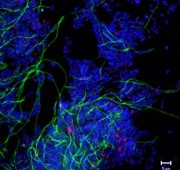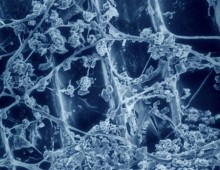Selected for the DOE JGI 2007 Community Sequencing Program because of traits such as high yield, perennial growth and low nutrient requirements, switchgrass is a promising candidate bioenergy crop that could be used to develop cellulosic biofuels. One of the challenges with sequencing switchgrass is the fact that it is a polyploid, containing multiple, full…
Effects of symbiosis on a fungal transcriptome
The soils of the boreal forests in the northern latitudes are estimated to store more than three times the amount of carbon contained in the atmosphere or in plant life on land. Recent studies suggest the relationship between fungi on the forest floor, plants and the microbial communities at the plant roots (or rhizosphere) plays…
Analysis of a TCE-degrading metagenome
Groundwater sites contaminated with compounds such as trichloroethene (TCE), a pervasive organic groundwater pollutant often used by industry as cleansers or degreasers.Dehalococcoidesbacteria, often found in a community of other microorganisms at groundwater sites contaminated with these compounds, can break down TCE and convert it into ethene, a harmless chemical compound often used to help ripen…
White rot fungal genomics analysis on EcoSeed
Scientists at the Energy Department’s Joint Genome Institute are comparing the genetic structure of two strains of white rot fungi in order to develop better enzymes for biofuel production.White rot fungi digest moist wood, causing it to rot and decay. These fungi possess natural enzymes that break down the cellulose, hemicelluloses and lignin of plant…
Searching for the basis of ligninolytic selectivity
Many fungal genome projects being carried out at the DOE JGI focus on understanding how enzymes can break down cellulose and lignin, the two most abundant biopolymers on Earth, in order to harness these capabilities for industrial applications such as biofuels production. Scanning electron micrograph of Ceriporiopsissubvermispora mycelium on wood. (Robert Blanchette, University of Minnesota)…
A science illustrator’s take on the DOE JGI 2012 Genomics of Energy & Environment Meeting
Science illustrator Emily Coren’s rendering of Carl Zimmer’s keynote presentation at the DOE JGI Genomics of Energy & Environment Meeting on March 20, 2012.
Pulp NonFiction: Fungal Analysis Reveals Clues for Targeted Biomass Deconstruction
Without fungi and microbes to break down dead trees and leaf litter in nature, the forest floor might look like a scene from TV’s “Hoarders.” Massive-scale genome sequencing projects supported by the U.S. Department of Energy (DOE) and being carried out at the DOE Joint Genome Institute (JGI) highlight the importance of learning how the…
DOE JGI Genomics of Energy and Environment Meeting coverage by GenomeWeb
Purdue University’s Jody Banks kicked off the scientific sessions at the US Department of Energy Joint Genome Institute’s 7th annual User Meeting in Walnut Creek, Calif., this week with her talk on the Selaginella genome and how sequencing diverse species could help researchers understand plant evolution. Read more at GenomeWeb
Bioinformatics challenges for metagenomic analyses
There are more microbes in, on and around the planet than there are stars in the sky. However, the vast majority of these microorganisms have not yet been studied, in part because many of them do not thrive when moved out of their natural environment. A spoonful of soil contains a complex and diverse microbial…
Elucidating bacteria’s roles in ant fungal gardens
Leafcutter ants cultivate fungal gardens that serve as their primary food source. Working toward the goal of harnessing novel enzymes for breaking down plant biomass to produce cellulosic biofuels, Great Lakes Bioenergy Research Center (GLBRC) researchers have been studying the process by which the fungi break down the plant leaves harvested by the ants and…

